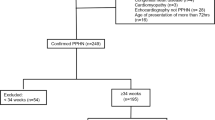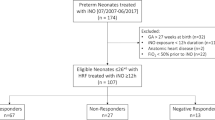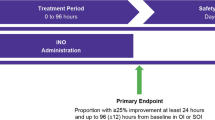Abstract
Objective:
Characteristics of preterm infants who develop pulmonary hypertension (PHT) and their response to inhaled nitric oxide (iNO) are not well described. Our objective was to identify risk factors for PHT in infants <37 weeks gestational age (GA) and to evaluate their response to iNO.
Study design:
A retrospective chart review was conducted in infants <37 weeks GA born from July/2000 to October/2005 who had an echocardiographic diagnosis of PHT in the first 4 weeks of life. A comparison non-PHT group was generated matched for GA and birth date. Data on prenatal and postnatal characteristics, response to iNO and mortality were collected.
Results:
Low Apgar scores, preterm premature rupture of membranes, oligohydramnios, pulmonary hypoplasia and sepsis were independently predictive of PHT. Mortality was significantly higher in the PHT group (26.2% versus 4.1%; P<0.0001) compared to the control group. Low birth weight, severe intraventricular hemorrhage and male sex were significantly associated with death in infants with PHT. Thirty-seven percent (23/61) of infants with PHT were treated with inhaled NO. Infants <29-week GA had poor response to iNO and the response to iNO increased with GA (P<0.02).
Conclusions:
Low Apgar scores, oligohydramnios and pulmonary hypoplasia are associated with the development of PHT in premature infants. The percentage of infants responding to iNO increases with advancing GA.
This is a preview of subscription content, access via your institution
Access options
Subscribe to this journal
Receive 12 print issues and online access
$259.00 per year
only $21.58 per issue
Buy this article
- Purchase on Springer Link
- Instant access to full article PDF
Prices may be subject to local taxes which are calculated during checkout



Similar content being viewed by others
References
Evans NJ, Archer LN . Doppler assessment of pulmonary artery pressure and extrapulmonary shunting in the acute phase of hyaline membrane disease. Arch Dis Child 1991; 66 (1 Spec No): 6–11.
Walther FJ, Benders MJ, Leighton JO . Title: Persistent pulmonary hypertension in premature neonates with severe respiratory distress syndrome. [see comment]. Pediatrics 1992; 90 (6): 899–904.
The Neonatal Inhaled Nitric Oxide Study Group. Inhaled nitric oxide in full-term and nearly full-term infants with hypoxic respiratory failure. N Engl J Med 1997; 336 (9): 597–604.
Roberts Jr JD, Fineman JR, Morin III FC, Shaul PW, Rimar S, Schreiber MD, The Inhaled Nitric Oxide Study Group et al. Inhaled nitric oxide and persistent pulmonary hypertension of the newborn. N Engl J Med 1997; 336 (9): 605–610.
Kinsella JP, Walsh WF, Bose CL, Gerstmann DR, Labella JJ, Sardesai S et al. Inhaled nitric oxide in premature neonates with severe hypoxaemic respiratory failure: a randomised controlled trial. Lancet 1999; 354 (9184): 1061–1065.
Schreiber MD, Gin-Mestan K, Marks JD, Huo D, Lee G, Srisuparp P . Inhaled nitric oxide in premature infants with the respiratory distress syndrome. N Engl J Med 2003; 349 (22): 2099–2107.
Van Meurs KP, Wright LL, Ehrenkranz RA, Lemons JA, Ball MB, Poole WK et al. Inhaled nitric oxide for premature infants with severe respiratory failure. N Engl J Med 2005; 353 (1): 13–22.
Rossaint R, Falke KJ, Lopez F, Slama K, Pison U, Zapol WM . Inhaled nitric oxide for the adult respiratory distress syndrome. N Engl J Med 1993; 328 (6): 399–405.
Roze JC, Storme L, Zupan V, Morville P, Dinh-Xuan AT, Mercier JC . Echocardiographic investigation of inhaled nitric oxide in newborn babies with severe hypoxaemia. Lancet 1994; 344 (8918): 303–305.
Kinsella JP, Parker TA, Galan H, Sheridan BC, Halbower AC, Abman SH . Effects of inhaled nitric oxide on pulmonary edema and lung neutrophil accumulation in severe experimental hyaline membrane disease. Pediatr Res 1997; 41 (4 Pt 1): 457–463.
Mourani PM, Ivy DD, Gao D, Abman SH . Pulmonary vascular effects of inhaled nitric oxide and oxygen tension in bronchopulmonary dysplasia. Am J Respir Crit Care Med 2004; 170 (9): 1006–1013.
Ballard RA, Truog WE, Martin RJ, Ballard PL, Cnaan A, Merrill JD . Improved outcome with inhaled nitric oxide in preterm infants mechanically ventilated at 7–21 days of age. PAS. late breaker abstract no 2. 2006.
Kinsella JP, Cutter GR, Walsh WF, Gerstmann DR, Bose CL, Hart C et al. Early inhaled nitric oxide therapy in premature newborns with respiratory failure. PAS. late breaker abstract no. 1, 2006.
Watkins AM, West CR, Cooke RW . Blood pressure and cerebral haemorrhage and ischaemia in very low birthweight infants. Early Hum Dev 1989; 19 (2): 103–110.
Skimming JW, Bender KA, Hutchison AA, Drummond WH . Nitric oxide inhalation in infants with respiratory distress syndrome. J Pediatr 1997; 130 (2): 225–230.
Geary C, Whitsett J . Inhaled nitric oxide for oligohydramnios-induced pulmonary hypoplasia: a report of two cases and review of the literature. J Perinatol 2002; 22 (1): 82–85.
Kabra NS, Kluckow MR, Powell J . Nitric oxide in preterm infant with pulmonary hypoplasia. Indian J Pediatr 2004; 71 (5): 427–429.
Kilbride HW, Thibeault DW . Neonatal complications of preterm premature rupture of membranes. Pathophysiology and management. Clin Perinatol 2001; 28 (4): 761–785.
Winn HN, Chen M, Amon E, Leet TL, Shumway JB, Mostello D . Neonatal pulmonary hypoplasia and perinatal mortality in patients with midtrimester rupture of amniotic membranes--a critical analysis. [see comment]. Am J Obstet Gynecol 2000; 182 (6): 1638–1644.
Acunas B, Greenough A, Dimitriou G, Gamsu H . Neonatal outcome following early onset preterm premature rupture of the membranes--a case controlled study. Turk J Pediatr 1999; 41 (4): 429–436.
Bhutani VK, Abbasi S, Weiner S . Neonatal pulmonary manifestations due to prolonged amniotic leak. Am J Perinatol 1986; 3 (3): 225–230.
Broth RE, Wood DC, Rasanen J, Sabogal JC, Komwilaisak R, Weiner S et al. Prenatal prediction of lethal pulmonary hypoplasia: the hyperoxygenation test for pulmonary artery reactivity. Am J Obstet Gynecol 2002; 187 (4): 940–945.
Bland RD, Ling CY, Albertine KH, Carlton DP, MacRitchie AJ, Day RW et al. Pulmonary vascular dysfunction in preterm lambs with chronic lung disease. Am J Physiol Lung Cell Mol Physiol 2003; 285 (1): L76–85.
Morin III FC, Egan EA . Pulmonary hemodynamics in fetal lambs during development at normal and increased oxygen tension. J Appl Physiol 1992; 73 (1): 213–218.
Morin III FC, Egan EA, Ferguson W, Lundgren CE . Development of pulmonary vascular response to oxygen. Am J Physiol 1988; 254 (3 Pt 2): H542–H546.
Tiktinsky MH, Morin III FC . Increasing oxygen tension dilates fetal pulmonary circulation via endothelium-derived relaxing factor. Am J Physiol 1993; 265 (1 Pt 2): H376–H380.
Rasanen J, Wood DC, Debbs RH, Cohen J, Weiner S, Huhta JC . Reactivity of the human fetal pulmonary circulation to maternal hyperoxygenation increases during the second half of pregnancy: a randomized study. Circulation 1998; 97 (3): 257–262.
Barrington KJ, Finer NN . Inhaled nitric oxide for respiratory failure in preterm infants.[update of Cochrane Database Syst Rev. 2001;(3):CD000509; PMID: 11686963]. [Review] [31 refs]. Cochrane Database of Systematic Reviews 2001; (4): CD000509.
Author information
Authors and Affiliations
Corresponding author
Rights and permissions
About this article
Cite this article
Kumar, V., Hutchison, A., Lakshminrusimha, S. et al. Characteristics of pulmonary hypertension in preterm neonates. J Perinatol 27, 214–219 (2007). https://doi.org/10.1038/sj.jp.7211673
Received:
Revised:
Accepted:
Published:
Issue Date:
DOI: https://doi.org/10.1038/sj.jp.7211673
Keywords
This article is cited by
-
Predictors of adverse short-term outcomes in late preterm infants
BMC Pediatrics (2023)
-
Response categorization and outcomes in extremely premature infants born at 22–26 weeks gestation that received inhaled nitric oxide for hypoxic respiratory failure
Journal of Perinatology (2023)
-
Risk factors of early pulmonary hypertension and its clinical outcomes in preterm infants: a systematic review and meta-analysis
Scientific Reports (2022)
-
Role of functional echocardiographic parameters in the diagnosis of bronchopulmonary dysplasia-associated pulmonary hypertension
Journal of Perinatology (2022)
-
Pulmonary hypertension in late onset neonatal sepsis using functional echocardiography: a prospective study
Journal of Ultrasound (2022)



